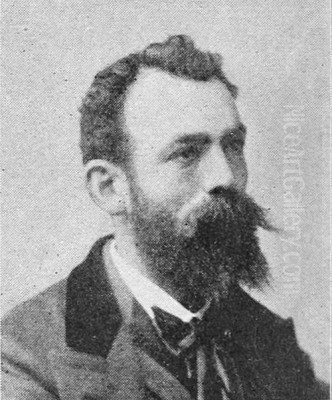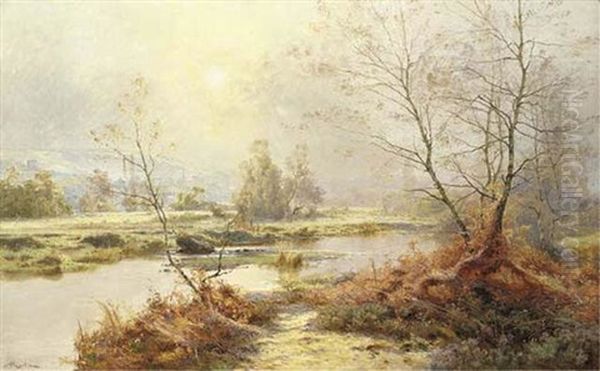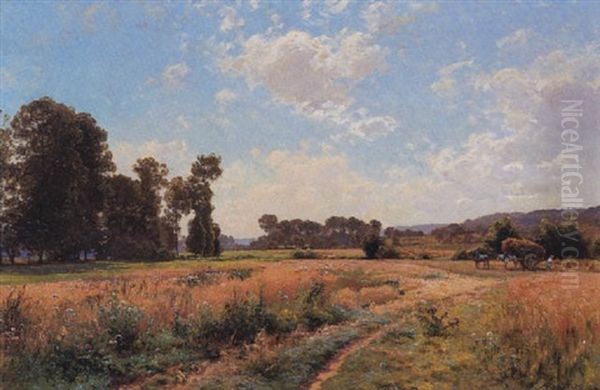
Albert Gabriel Rigolot stands as a significant figure in French landscape painting during the late nineteenth and early twentieth centuries. Born in Paris in 1862 and passing away in the same city in 1932, Rigolot dedicated his artistic life to capturing the nuances of light and atmosphere, first within the familiar settings of the French countryside and later under the brilliant sun of North Africa. His work, rooted in the Naturalist tradition yet infused with a personal sensitivity to color and light, earned him considerable recognition during his lifetime and secured his place as a respected artist of his era.
Early Influences and Artistic Formation
Rigolot's artistic journey began in his native Paris, a city that was then the undisputed center of the Western art world. Showing promise from a young age, he sought formal training to hone his innate talents. A pivotal moment came in 1885 when he began studying under Léon Germain Pelouse (1838-1891). Pelouse was a respected landscape painter associated with the Barbizon School's legacy, known for his atmospheric depictions of the Île-de-France region. Under Pelouse's guidance, Rigolot would have absorbed the principles of painting directly from nature (plein air painting) and developed a keen eye for the subtle effects of light on the landscape.
Further refining his skills, Rigolot commenced studies with Auguste Allongé (1833-1898) in 1889. Allongé, particularly renowned for his mastery of charcoal drawing and his influential instructional manuals on landscape drawing, likely imparted a strong sense of structure and composition to Rigolot's developing style. This combination of Pelouse's painterly approach and Allongé's emphasis on draftsmanship provided a solid foundation for Rigolot's future work.

His formal education also included a period at the prestigious Académie Julian between 1890 and 1893. This famous private art school was a melting pot of artistic ideas and attracted students from across France and abroad. While there, Rigolot would have been exposed to a diverse range of artistic currents and interacted with fellow students and established instructors, further broadening his artistic horizons. The Académie Julian was known for its less rigid structure compared to the official École des Beaux-Arts, fostering a dynamic environment where artists like Pierre Bonnard and Édouard Vuillard also spent time, though perhaps not concurrently with Rigolot.
Debut and Recognition at the Salon
The Paris Salon, the official exhibition organized by the Académie des Beaux-Arts (and later by the Société des Artistes Français), was the primary venue for artists seeking recognition and patronage in the late nineteenth century. Making a successful debut at the Salon was a crucial step in launching a professional career. Albert Gabriel Rigolot achieved this milestone in 1886, exhibiting his work for the first time to the Parisian public and critics.
His participation was not a fleeting event; Rigolot became a regular exhibitor at the Salon for many years, demonstrating his commitment to the established art system. His consistent presence and the quality of his submissions soon brought him official accolades. In 1889, he received an Honorable Mention, a significant acknowledgment for a relatively young artist. This was followed by a Bronze Medal (Third Class) in 1891 and, demonstrating his growing stature, a Silver Medal (Second Class) in 1892.
These awards were not merely symbolic; they signified critical approval and helped build the artist's reputation, potentially leading to sales and commissions. Rigolot's success within the Salon framework indicates that his style, while rooted in observation, resonated with the prevailing tastes of the time, which still valued technical skill and recognizable subject matter, even as more radical movements like Impressionism, championed by artists such as Claude Monet and Camille Pissarro, were challenging academic norms.
The Naturalist Vision: French Landscapes
Rigolot's primary artistic identity, particularly in the earlier part of his career, was that of a Naturalist landscape painter. He excelled in depicting the serene beauty of the French countryside, with a particular fondness for river scenes and tranquil woodland settings. His work clearly shows the influence of the Barbizon School painters like Jean-Baptiste-Camille Corot and Charles-François Daubigny, who had earlier championed the realistic and poetic portrayal of rural France.

Like the Barbizon masters, Rigolot was deeply interested in the effects of light and atmosphere. He possessed a remarkable ability to render the way sunlight filters through leaves, dapples on the ground, and reflects off the surface of water. His paintings often capture specific times of day – the soft glow of morning, the bright clarity of midday, or the long shadows of late afternoon. He sought to convey the tranquility and inherent purity of the natural world, often choosing quiet, contemplative scenes away from the bustle of urban life.
His technique involved a careful observation of nature, likely involving plein air sketching, combined with studio work to refine compositions and effects. While adhering to a Naturalist framework, his brushwork was often described as free and his color palette flexible, suggesting a move away from the tighter finish of purely academic painting towards a more personal and expressive rendering of the observed world. He captured the lush greens of French summers, the golden tones of autumn, and the misty ambiance of river valleys with sensitivity and skill.
The Allure of the Orient: Algerian Journeys
A significant development in Rigolot's artistic trajectory occurred in the late 1890s when he traveled to Algeria. This journey immersed him in the vibrant light, distinct landscapes, and different cultural environment of North Africa, leading to a distinct Orientalist phase in his work. France had a long tradition of Orientalist painting, dating back to Eugène Delacroix and continuing through artists like Jean-Léon Gérôme and Eugène Fromentin. Rigolot engaged with this tradition, seeking to capture the unique visual character of Algeria.
His travels brought a noticeable shift in his palette and subject matter. Inspired by the intense North African sunlight, his colors became brighter and warmer. He aimed to translate the luminosity he experienced, creating what some described as a "paradise of light" in his canvases. Subjects expanded to include Algerian landscapes, potentially featuring local architecture, flora, and scenes of daily life, such as the harvest scenes mentioned in some accounts.
Rigolot became associated with the Société des Peintres Orientalistes Français (Society of French Orientalists), a group dedicated to promoting art inspired by North Africa, the Middle East, and Asia. This connection underscores the importance of his Algerian experience. His Orientalist works offered a contrast to his more temperate French landscapes, showcasing his versatility and his ability to adapt his style to different environments. These paintings captured the exotic allure that North Africa held for many Europeans at the time, blending observed reality with a sense of the picturesque. Contemporary Orientalists like Nasreddine Dinet, who lived and worked in Algeria, were exploring similar themes.
Technique, Mediums, and Output
Throughout his career, Albert Gabriel Rigolot demonstrated proficiency in multiple mediums, primarily oil painting and watercolor. His oil paintings often possess a rich texture and depth of color, allowing him to build up layers of light and shadow effectively. His handling could range from relatively detailed passages to broader, more suggestive strokes, contributing to the overall atmospheric effect.
His watercolors showcase a different aspect of his talent, often characterized by a greater transparency and fluidity. This medium lent itself well to capturing fleeting effects of light and atmosphere, particularly the hazy mornings or the shimmering quality of water. His skill in watercolor was likely honed by his studies, perhaps influenced by Allongé's emphasis on drawing and tonal values.
Rigolot was a prolific artist. It is estimated that he produced around 1500 works, encompassing both oils and watercolors, throughout his lifetime. This substantial output reflects a dedicated and consistent working practice. His style, described as having a "free" quality and "flexible tones," suggests an artist confident in his technique, able to adapt his approach to suit the subject and the medium, whether depicting the gentle light of the Seine valley or the starker brilliance of the Algerian sun.
Key Works and Recurring Themes
While a comprehensive catalogue raisonné might be needed to fully assess his oeuvre, several works are frequently cited as representative of Albert Gabriel Rigolot's style and thematic concerns.
Soleil Levant dans la Brume (Rising Sun in the Mist): This title immediately evokes an atmospheric landscape, focusing on the interplay of light and mist at dawn. It suggests a work concerned with capturing a specific, transient moment in nature, highlighting Rigolot's interest in atmospheric effects, a theme explored intensely by Impressionists like Monet but rendered here likely through a more Naturalist lens.
Fin juillet (End of July): This title points to a seasonal landscape, likely depicting the French countryside in the height of summer. It suggests a focus on the lushness and warmth of the season, perhaps featuring ripe fields or dense foliage under a strong summer light.
Matinée de septembre dans la vallée de Chevreuse (September Morning in the Chevreuse Valley): This work specifies both a time and a place. The Chevreuse Valley, southwest of Paris, is known for its picturesque landscapes and was frequented by artists. A September morning suggests cooler light, perhaps early autumn colors, and a specific atmospheric quality that Rigolot aimed to capture.
Après la moisson; - Gâtinais (After the Harvest; - Gâtinais): This title indicates a rural scene set in the Gâtinais region, south of Paris. The theme of "after the harvest" suggests a landscape marked by human activity but perhaps depicted in a moment of quietude, focusing on the fields post-harvest, possibly under an autumn sky. It connects his work to a long tradition of depicting agricultural cycles and rural life, seen in artists from the Barbizon school to Jules Bastien-Lepage.
These examples illustrate Rigolot's consistent engagement with landscape, his sensitivity to seasonal changes and specific times of day, and his grounding in the French countryside, later complemented by his explorations of Algerian scenes.
Continued Recognition and Honors
Rigolot's success was not confined to the early part of his career. His established reputation was further solidified in 1900 when he was awarded a Silver Medal at the Exposition Universelle (World's Fair) in Paris. These large international exhibitions were major events, and receiving an award there brought significant prestige and international visibility.
Perhaps the highest official recognition came in 1901 when Albert Gabriel Rigolot was named a Chevalier de la Légion d'honneur (Knight of the Legion of Honour). This prestigious French order of merit is awarded for outstanding civil or military service. For an artist, receiving the Légion d'honneur was a mark of significant national recognition, placing him among the respected figures of French culture. It acknowledged his contributions to the arts and his standing within the official art establishment. His continued participation in Salons and these major awards demonstrate a career marked by sustained professional success and peer recognition.
Influence and Artistic Legacy
While perhaps not as revolutionary as the Impressionists or Post-Impressionists like Paul Cézanne or Vincent van Gogh, Albert Gabriel Rigolot carved out a respected place for himself within the French art scene. His legacy lies primarily in his skillful continuation and personal interpretation of the Naturalist landscape tradition. He was admired for his technical proficiency, particularly his handling of light and atmosphere.
His role as a teacher also contributed to his influence. Records indicate that several artists studied with him or were guided by his example. These include the Welsh artist John Hafren (1878-1970), Lorris Prat, and notably, two American artists associated with the Mormon community in Utah: J.B. Fairbanks (John B. Fairbanks, 1855-1940) and Edwin Evans (1860-1946). Fairbanks and Evans traveled to Paris to study, and their time with Rigolot would have exposed them to contemporary French academic and Naturalist techniques, which they subsequently brought back to their work in the United States. This demonstrates that Rigolot's influence extended beyond France.
In the broader sweep of art history, Rigolot represents a significant current of late 19th and early 20th-century French art that maintained a connection to representational accuracy and traditional landscape values, even as Modernism, with movements like Fauvism led by Henri Matisse and André Derain, began to radically transform the artistic landscape.
Rigolot and His Contemporaries
Albert Gabriel Rigolot's career spanned a period of immense artistic ferment in France. He worked alongside generations of artists who were shaping the future of art. His teachers, Pelouse and Allongé, connected him to the Barbizon legacy. His Salon participation placed him in dialogue with academic painters and other successful Naturalists like Pascal Dagnan-Bouveret.
He was a contemporary of the major Impressionists (Auguste Renoir, Monet, Pissarro) and Post-Impressionists (Cézanne, Van Gogh, Paul Gauguin), though his artistic path diverged from their more radical experiments with form and color. His Orientalist phase connected him to that specific genre and artists like Gérôme and Fromentin, as well as contemporaries exploring North Africa.
Later in his career, he would have witnessed the emergence of Symbolism (Gustave Moreau, Odilon Redon), Fauvism, and Cubism. While Rigolot remained largely faithful to his Naturalist roots, his work existed within this dynamic context. He represented a successful, respected artist working within established traditions, providing a counterpoint to the avant-garde movements that often dominate historical narratives.
Collections and Current Standing
Information regarding the specific current locations of Albert Gabriel Rigolot's works in major public collections is not readily available from the provided sources. While his Salon participation and awards suggest his work was acquired during his lifetime, the sources consulted do not confirm holdings in institutions like the Musée d'Orsay or other major French national museums, nor in prominent collections elsewhere in Europe.
It is common for works by successful Salon artists of this period to be found in regional French museums (Musées des Beaux-Arts in various cities) or to remain in private collections. Rigolot's paintings and watercolors continue to appear on the art market, where they are appreciated by collectors interested in French landscape painting, Naturalism, and Orientalism of the late 19th and early 20th centuries. His consistent quality and appealing subject matter ensure a continued interest in his work.
Conclusion: A Master of Light and Place
Albert Gabriel Rigolot was a distinguished French painter whose career successfully navigated the established art world of the late nineteenth and early twentieth centuries. From his early training with masters like Pelouse and Allongé, through his consistent success at the Paris Salon, to the prestigious recognition of the Legion of Honour, he built a reputation based on technical skill and a sensitive eye for the natural world.
His legacy rests on his beautiful and atmospheric depictions of the French landscape, particularly his masterful rendering of light filtering through trees and reflecting on water, carrying forward the spirit of the Barbizon school. Furthermore, his significant body of Orientalist work, inspired by his travels to Algeria, adds another dimension to his oeuvre, showcasing his ability to capture the brilliant light and distinct character of North Africa. As a respected teacher and a prolific artist, Albert Gabriel Rigolot remains an important figure for understanding the breadth of French painting during a transformative period in art history.